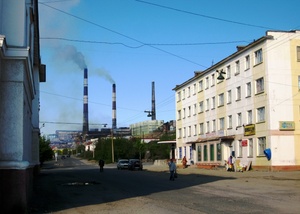
New Managing Director for Bellona Norway
The Board of the Bellona Foundation has appointed former Minister of Climate and the Environment Sveinung Rotevatn as Managing Director of Bellona No...
News

Publish date: June 5, 2017
Written by: Anna Kireeva
News
More than two decades of successful environmental cooperation between Norway and Russia, especially on coping with the Cold War nuclear legacy, still hasn’t reduced deadly sulfur dioxide emissions from the Kola Mining and Metallurgy Company wafting over the Norwegian border.
When the two sides recently came together at a meeting of the Joint Norwegian-Russian Commission on Environmental Protection, Sergei Donskoi, Russia’s natural resources minister, put out a statement: “For 25 years, Russia and Norway have developed cooperation in the field of environmental protection. Ever since the moment when our two country’s signed an agreement in 1992 the cooperation serves as a stabilizing factor in our relations.”
That may be the case in certain areas, but when it concerns pollution from the Kola Peninsula daughter corporation of the giant Norilsk Nickel, discussions have offered anything but stability, and frustrations over years of promises made Norwegian officials testy.
Within the commission, one working group deals with air quality monitoring as a cooperative effort between the Murmansk Region and the Norwegian county of Finnmark. Other working groups are tasked with monitoring radioactive contamination, and yet others address biodiversity and pollution reduction.
Vidar Helgesen, Norway’s Minister of Climate and the Environment, who participated in the commission’s meeting, subsequently told a Bellona seminar that many areas of joint cooperation function well, but that the issue of sulfur dioxide billowing into Norway from Russia continues to be vexing.
 The smokestacks at the Kola Mining and Metallurgy Company. (Photo: Anna Kireeva)
The smokestacks at the Kola Mining and Metallurgy Company. (Photo: Anna Kireeva)
In Helgesen’s estimation, Norilsk Nickel, headed by Russian oligarch Vladimir Potantin, has been making billions of dollars that could be devoted to environmental upgrades if the company wanted to make them.
For its part, Norilsk Nickel has said it will commit significant funding to just that, but it continues to be vague about what, exactly, it will do.
This is particularly true of what will happen at the Kola Mining and Metallurgy Company. In a December meeting with President Vladimir Putin, Potanin promised to spend $4.9 billion company wide on environmental projects. A spokesman later said the Kola Mining and Metallurgy Company would see $460 million of that for upgrades of its own.
But Helgesen said that over the past year alone, he has raised questions about the specifics of Norilsk Nickel’s well-heeled modernization program with Donskoi and not received a response.
“The representatives of the Kola MMC have presented plans for definite improvements of the situation in a short-term perspective,” Helgesen told the Bellona seminar. “But even if they implement them, sulfur dioxide emissions will still remain very high.”
At the commission meeting, Rune Rafaelsen, the crusading mayor of Sør Varanger – the Northern Norwegian town that has suffered the brunt of sulfer dioxide pollution – suggested Norilsk Nickle’s owners shouldn’t be allowed to profit from polluting.
Speaking to Donskoi, Rafaelsen singled out Potanin and Russian aluminum billionaire Oleg Deripaska, for polluting the Arctic region.
”They have made so much money on this that if they wanted to solve this environmental problem, they already would have,” Rafaelsen said. Rafaelson made waves in 2016 by suggesting Europe slap sanctions and travel restrictions on Potanin and other company officials, as well as impound Potation’s Europe-based yacht.
 Kirkenes Mayor Rune Rafaelsen. (Photo: sverigesradio.se)
Kirkenes Mayor Rune Rafaelsen. (Photo: sverigesradio.se)
“The sulfur dioxide emissions from Russia are one of the most serious ecological problems in Norway,” he told Donskoi at the commission meeting. “I am the leader of Sør Varanger, and I answer for the citizens living there – the people living in the Arctic region have a right to clean air.”
Rafaelsen said afterward that that the tone of his words had raised Donskoi’s hackles, but Helgesen seemed to agree that sharp words were warranted.
“Reducing emissions is the responsibility of the Russian side,” he said. “We will continue to raise the issue at joint meetings until the emission fall to a level that aren’t causing a negative effect on the environmental and people’s health in the border area.”
If those emissions are getting to that level is still a matter of dispute. In April, the Kola division posted a surprising 20 percent drop in sulfur dioxide emissions, for a total of 119,700 tons. The company also promised to drop is emissions to 51,000 tons a year by 2019.
But Rafaelsen said even that won’t be enough.

The Board of the Bellona Foundation has appointed former Minister of Climate and the Environment Sveinung Rotevatn as Managing Director of Bellona No...

Økokrim, Norway’s authority for investigating and prosecuting economic and environmental crime, has imposed a record fine on Equinor following a comp...

Our op-ed originally appeared in The Moscow Times. For more than three decades, Russia has been burdened with the remains of the Soviet ...

The United Nation’s COP30 global climate negotiations in Belém, Brazil ended this weekend with a watered-down resolution that failed to halt deforest...